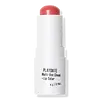What's inside
What's inside
 Key Ingredients
Key Ingredients

 Benefits
Benefits

 Concerns
Concerns

 Ingredients Side-by-side
Ingredients Side-by-side

Caprylic/Capric Triglyceride
MaskingSilica
AbrasiveMica
Cosmetic ColorantOctyldodecanol
EmollientCI 77163
Cosmetic ColorantHydrogenated Polyisobutene
EmollientPolyhydroxystearic Acid
EmulsifyingEuphorbia Cerifera Wax
Calcium Sodium Borosilicate
Behenyl Behenate
EmollientSorbitan Isostearate
EmulsifyingCI 77891
Cosmetic ColorantSucrose Tetrastearate Triacetate
EmollientTocopheryl Acetate
AntioxidantCI 77120
Cosmetic ColorantCI 19140
Cosmetic ColorantEthylhexylglycerin
Skin ConditioningCI 15850
Cosmetic ColorantDisteardimonium Hectorite
StabilisingAluminum Hydroxide
EmollientCI 73360
Cosmetic ColorantCI 77491
Cosmetic ColorantPropylene Carbonate
SolventSalicornia Herbacea Extract
Skin ConditioningTocopherol
AntioxidantCaprylic/Capric Triglyceride, Silica, Mica, Octyldodecanol, CI 77163, Hydrogenated Polyisobutene, Polyhydroxystearic Acid, Euphorbia Cerifera Wax, Calcium Sodium Borosilicate, Behenyl Behenate, Sorbitan Isostearate, CI 77891, Sucrose Tetrastearate Triacetate, Tocopheryl Acetate, CI 77120, CI 19140, Ethylhexylglycerin, CI 15850, Disteardimonium Hectorite, Aluminum Hydroxide, CI 73360, CI 77491, Propylene Carbonate, Salicornia Herbacea Extract, Tocopherol
C12-15 Alkyl Benzoate
AntimicrobialIsononyl Isononanoate
EmollientPhenyl Trimethicone
Skin ConditioningSynthetic Wax
AbrasiveCaprylic/Capric Triglyceride
MaskingSilica
AbrasiveSynthetic Fluorphlogopite
Microcrystalline Wax
Emulsion StabilisingPentaerythrityl Adipate/Caprate/Caprylate/Heptanoate
EmollientTrimethylsiloxysilicate
EmollientPropylene Glycol Dicaprylate/Dicaprate
EmollientSorbitan Isostearate
EmulsifyingPolyhydroxystearic Acid
EmulsifyingLecithin
EmollientCaprylyl Glycol
EmollientTocopheryl Acetate
AntioxidantPolyglyceryl-3 Polyricinoleate
EmulsifyingIsostearic Acid
CleansingIsopropyl Myristate
EmollientEthylhexylglycerin
Skin ConditioningEthylhexyl Palmitate
EmollientStearalkonium Hectorite
Gel FormingAluminum Hydroxide
EmollientTin Oxide
AbrasivePropylene Carbonate
SolventTriethoxycaprylylsilane
Titanium Dioxide
Cosmetic ColorantIron Oxides
CI 15850
Cosmetic ColorantCI 19140
Cosmetic ColorantC12-15 Alkyl Benzoate, Isononyl Isononanoate, Phenyl Trimethicone, Synthetic Wax, Caprylic/Capric Triglyceride, Silica, Synthetic Fluorphlogopite, Microcrystalline Wax, Pentaerythrityl Adipate/Caprate/Caprylate/Heptanoate, Trimethylsiloxysilicate, Propylene Glycol Dicaprylate/Dicaprate, Sorbitan Isostearate, Polyhydroxystearic Acid, Lecithin, Caprylyl Glycol, Tocopheryl Acetate, Polyglyceryl-3 Polyricinoleate, Isostearic Acid, Isopropyl Myristate, Ethylhexylglycerin, Ethylhexyl Palmitate, Stearalkonium Hectorite, Aluminum Hydroxide, Tin Oxide, Propylene Carbonate, Triethoxycaprylylsilane, Titanium Dioxide, Iron Oxides, CI 15850, CI 19140
Ingredients Explained
These ingredients are found in both products.
Ingredients higher up in an ingredient list are typically present in a larger amount.
Aluminum Hydroxide is a form of aluminum. It can be naturally found in nature as the mineral gibbsite. In cosmetics, Aluminum Hydroxide is used as a colorant, pH adjuster, and absorbent.
As a colorant, Aluminum Hydroxide may add opacity, or reduce the transparency. Aluminum hydroxide is contains both basic and acidic properties.
According to manufacturers, this ingredient is an emollient and humectant. This means it helps hydrate the skin.
In medicine, this ingredient is used to help relieve heartburn and help heal ulcers.
There is currently no credible scientific evidence linking aluminum hydroxide in cosmetics to increased cancer risk.
Major health organizations allow the use of aluminum hydroxide in personal care products and have not flagged it as a carcinogenic risk at typical usage levels.
Learn more about Aluminum HydroxideThis ingredient is an emollient, solvent, and texture enhancer. It is considered a skin-softener by helping the skin prevent moisture loss.
It helps thicken a product's formula and makes it easier to spread by dissolving clumping compounds.
Caprylic Triglyceride is made by combining glycerin with coconut oil, forming a clear liquid.
While there is an assumption Caprylic Triglyceride can clog pores due to it being derived from coconut oil, there is no research supporting this.
Learn more about Caprylic/Capric TriglycerideCi 15850 is the pigment color red. It is an azo dye and created synthetically.
Azo dyes need to be thoroughly purified before use. This allows them to be more stable and longer-lasting.
This ingredient is common in foundations, lipsticks, and blushes. This color is described as brown/orangey red.
It has many secondary names such as Red 6 and Red 7. According to a manufacturer, Red 6 usually contains aluminum.
Learn more about CI 15850CI 19140 is also known as Tartrazine. Tartrazine is a synthetic dye used in cosmetics, foods, and medicine to add a yellow color.
Tartrazine is created from petroleum and is water-soluble.
Some people may experience allergies from this dye, especially asthmatics and those with an aspirin intolerance.
Learn more about CI 19140Ethylhexylglycerin (we can't pronounce this either) is commonly used as a preservative and skin softener. It is derived from glyceryl.
You might see Ethylhexylglycerin often paired with other preservatives such as phenoxyethanol. Ethylhexylglycerin has been found to increase the effectiveness of these other preservatives.
Polyhydroxystearic Acid is a soft wax made from castor oil.
It is is a texture thickener, emulsifier, and film-former. Emulsifiers prevent ingredients from separating, such as oils and waters.
Polyhydroxystearic Acid may not be fungal acne safe.
Learn more about Polyhydroxystearic AcidThis ingredient is a solvent. It helps dissolve active ingredients and alter the texture of products.
Propylene Carbonate is commonly used in makeup and with clay, such as montmorillonite or bentonite.
Studies show this ingredient to be safe for cosmetics. When it is undiluted, it can cause skin irritation. (It is always diluted in skincare and makeup). This ingredient is water-soluble.
Propylene Carbonate is created from propylene glycol and carbonic acid.
Learn more about Propylene CarbonateSilica, also known as silicon dioxide, is a naturally occurring mineral. It is used as a fine, spherical, and porous powder in cosmetics.
Though it has exfoliant properties, the function of silica varies depending on the product.
The unique structure of silica enhances the spreadability and adds smoothness, making it a great texture enhancer.
It is also used as an active carrier, emulsifier, and mattifier due to its ability to absorb excess oil.
In some products, tiny microneedles called spicules are made from silica or hydrolyzed sponge. When you rub them in, they lightly polish away dead skin layers and enhance the penetration of active ingredients.
Learn more about SilicaSorbitan Isostearate is an emulsifer and cleaning agent. It is created from isostearic acid and sorbitol.
As an emulsifier, Sorbitan Isostearate prevents oils and water from separating.
Due to its isostearic acid base, it may not be safe for Malassezia or fungal acne.
Learn more about Sorbitan IsostearateTocopheryl Acetate is AKA Vitamin E. It is an antioxidant and protects your skin from free radicals. Free radicals damage the skin by breaking down collagen.
One study found using Tocopheryl Acetate with Vitamin C decreased the number of sunburned cells.
Tocopheryl Acetate is commonly found in both skincare and dietary supplements.
Learn more about Tocopheryl Acetate